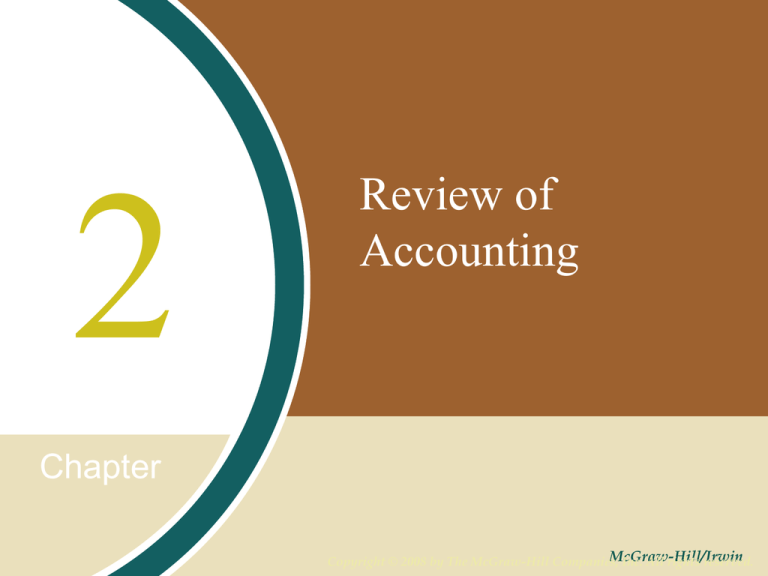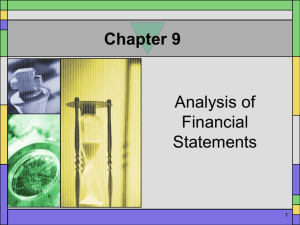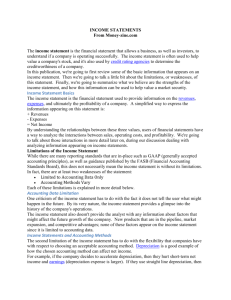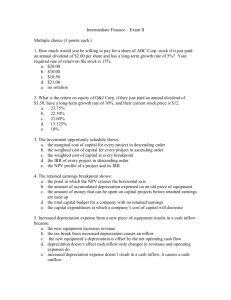
2
Review of
Accounting
Chapter
McGraw-Hill/Irwin
Copyright © 2008 by The McGraw-Hill Companies,
Inc. All rights reserved.
Chapter Outline
•
•
•
•
•
Income Statement
Price-earnings Ratio
Balance Sheet
Statement of Cash Flows
Tax-free Investments (Deprecation)
1-2
Basic Financial Statements
• Income Statement
• Balance Sheet
• Statement of Cash Flows
1-3
Income Statement
• Device to measure the profitability of a firm
over a period of time
– It covers a defined period of time
– It is presented in a stair-step or progressive
fashion to examine profit or loss after each type
of expense item is deducted
1-4
Income Statement (cont’d)
Sales – Cost of Goods Sold (COGS)
= Gross Profit (GP)
GP – Expenses = Earnings Before Interest and
Taxes (EBIT) or Operating Income (OI)
EBIT – Interest = Earnings Before Taxes (EBT)
EBT – Taxes = Earnings After Taxes (EAT) or Net
Income (NI)
1-5
Return to Capital
• Three primary sources of capital:
– Bondholders
– Preferred stockholders
– Common stockholders
• Earnings per share
– Interpreted in terms of number of outstanding
shares
– May be paid out in dividends or retained by
company for subsequent reinvestment
1-6
Price-Earnings (P/E) Ratio
• Multiplier applied to earnings per share to
determine current value of common stock
• Some factors that influence P/E:
– Earnings and sales growth of the firm
– Risk (volatility in performance)
– Debt-equity structure of the firm
– Dividend payment policy
– Quality of management
1-7
Price-Earnings (P/E) Ratio (cont’d)
• Allows comparison of the relative market
value of many companies based on $1 of
earnings per share
– Indicates expectations about the future of a
company
• Price-earnings ratios can be confusing
1-8
Price-earnings Ratios
for Selected US Companies
1-9
Balance Sheet
• Indicates what the firm owns and how these
assets are financed in the form of liabilities
or ownership interest
– Delineates the firm’s holdings and obligations
– Items are stated on an original cost basis rather
than at current market value
1-10
Balance Sheet Items
• Liquidity: Asset accounts are listed in order
of liquidity
– Current assets
• Items that can be converted to cash within 12 months
– Marketable securities
• Temporary investments of excess cash
– Accounts receivable
• Allowance for bad debts to determine their anticipated
collection value
– Inventory
• Includes raw materials, goods in progress, or finished
goods
1-11
Balance Sheet Items (cont’d)
– Prepaid expenses
• Represent future expense items that are already paid
for
– Investments
• Long-term commitment of funds
• Includes stocks, bonds, or investments in other
companies
– Plant and equipment
• Carried at original cost minus accumulated
depreciation
• Accumulated depreciation
– Sum of past and present depreciation charges on currently
owned assets
1-12
Balance Sheet Items (cont’d)
• Depreciation expense is the current year’s charge
– Total assets: Financed through liabilities or
stockholders’ equity
• Short-term obligations
– Accounts payable
– Notes payable
– Accrued expense
1-13
Stockholder’s Equity
• Represents total contribution and ownership
interest of preferred and common
stockholders
– Preferred stock
– Common stock
– Capital paid in excess of par
– Retained earnings
1-14
Concept of Net Worth
Net worth/book value = Stockholders’ equity –
preferred stock component
• Market value is of primary concern to the:
– Financial manager
– Security analyst
– Stockholders
1-15
Concepts Behind the Statement of
Cash Flows
1-16
Depreciation and Funds Flow
• Depreciation
– Attempt to allocate the initial cost of an asset
over its useful life
• Charging of depreciation does not directly
influence the movement of funds
1-17
Comparison of Accounting
and Cash Flows
1-18
Income Tax Considerations
• Corporate tax rates
– Progressive: the top rate is 40% including state
and foreign taxes if applicable. The lower
bracket is 15–20%
• Cost of a tax-deductible expense
1-19
Depreciation as a Tax Shield
• Not a new source of fund
• Provides tax shield benefits measurable as
depreciation times the tax rate
Earnings before depreciation and taxes……
Depreciation………………………………………
Earnings before taxed…………………………
Taxes (40%)………………………………………
Earnings after taxes……………………………
+Depreciation charged without cash outlay…
Cash flow…………………………………………
Difference…………………………………………
Corporation A
Corporation B
$400,000
100,000
_________
300,000
120,000
_________
180,000
100,000
_________
$280,000
$40,000
$400,000
0
_________
400,000
160,000
_________
240,000
0
_________
$240,000
1-20








